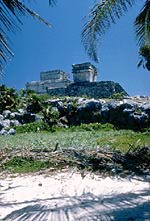Facing The Future:
People and the Planet

The Age of European Expansion
Historically, shortages of farmland, water
for irrigation, timber for construction and fuel, or minerals for manufacturing
all limited population size and economic opportunities. Lack of work, economic
instability, local food scarcity, and lack of available land also drove
migration and conflict, as people competed for those re–sources.
The Potato and the American Civil War
When Spain and Portugal began their colonial expansion, northern Europe
was largely a backwater. Shorter growing seasons limited grain production,
so the area lacked the caloric resources to undertake significant exploration
and conquest.
But when Spanish explorers brought the potato back from South America,
everything changed. Potatoes grew well in cooler climates, and provided
lots of calories. With more food available, population increased rapidly
in England, Holland, Germany, Poland and Sweden. When those countries faced
shortages of farmland, jobs, and other resources due to population growth,
they experienced massive out-migration, primarily to the northern US.
Because of this influx, US population grew roughly 35% every decade from
1800 to 1860. This caused a huge demographic shift. In 1800, the South
was home to half the US population. but by 1860, it represented just over
one-third.
In 1847 the Union comprised 15 slave and 14 free states, so southerners
maintained control of the US Senate. But as immigration fueled western
expansion, new states began to arise. The South tried desperately to ward
this off. It stonewalled the Homestead Act and the transcontinental railroad,
because those would promote western settlement. And it attempted to create
new states where southern institutions could flourish. In the 1840's and
50's, southerners led or sponsored three attempted invasions of Cuba, three
efforts to seize Nicaragua, and one invasion of Baja California. They also
tried to purchase the northern third of Mexico.
None of these efforts were successful, nor could they offset the relentless
forces of population growth. By 1860, slave states were a minority, and
political power had shifted north. By 1861, southerners knew they had only
two choices. Either surrender slavery, or fight (and win) a war of secession.
|
But those effects tended, for the most part,
to be localized. People migrated from country to city, and neighboring
or regional civilizations clashed. So while the distribution of resources
changed with the ebb and flow of cultures, the general availability of
resources in any given region did not increase. The Europeans broke out
of this pattern, however, when they began to conquer and colonize distant
areas of the world.
The first Europeans to actively colonize
other regions were the Vikings. The forces behind their expansion were
complex, but scarcity of farmland was a key element. As historian J.M.
Roberts wrote, "These Scandinavians combined trade, piracy and colonization,
stimulated by land hunger."
The first known Viking raid occurred in
793 C.E., and over the next 400 years they discov–ered and settled the
Faroe Islands, Iceland, Greenland, and parts of Newfoundland.
Moving east and south, the Vikings penetrated
the heartland of Russia (which is named for the Rus, as the Vikings were
called there) and founded city-states such as Kiev and Novgorod. They raided
as far south as Constantinople and Baghdad, and threatened French cities
to the point that they were given huge tracts of land in what is now Normandy
("land of the Northmen") in exchange for peace. And they conquered much
of the richest farmland of Northern England and Ireland.
By the early 15th century, Portugal had
begun to explore and exploit the West Coast of Africa. The wealth they
captured created an economic and population boom at home, and stimulated
further explorations. The Portuguese pushed down the coast of Africa, then
eastward. They established trading colonies in India about the time Columbus
reached the Caribbean, and launched the era of Spanish exploration and
colonization.
While the early European empires were seen
primarily as sources of wealth, the flood of resources they returned to
Europe caused a profound shift. As expected, increased prosperity stimulated
local population growth in Portugal and Spain. But new protein sources
increased the ability of northern European nations to produce food, and
their populations began to expand rapidly.
Less than 100 years after the introduction
by the Spanish of the potato from South America and maize corn from Mexico,
England and Holland had joined the scramble for overseas colonies.
This new burst of growth (world population
grew as much between 1500 and 1750 as it had in the previous 1500 years)
created renewed scarcities, particularly of farmland. Because of this,
smaller nations such as England and Hol–land began to see colonies not
only as a place to obtain resources
from, but also a place to send
excess population to.
This trend continued through the 19th century,
with nations such as Germany, Sweden, and Norway, as well as British-occupied
Ireland, also reducing population pressure through emigration to North
America.
Conflict between nations intensified throughout
the Age of Expansion, as competing powers fought over trade routes and
access to resources in North and South America, Asia and Africa. But conflict
also occurred on a more local scale, as the new arrivals clashed with indigenous
populations.
As European settlers expanded across North
America, for example, they displaced or dispossessed Native inhabitants.
Those peoples were then forced to migrate, and subsequently displaced the
tribes onto whose lands they were driven. If they failed to do so, they
vanished as a culture.
As Americans pushed further west in search
of more land and resources to supply a growing population, more clashes
followed.
By the time the western edge of the continent
was reached, the new immigrants controlled the majority of land and resources,
and most surviving indigenous populations were relegated to reservations.
Click here to return
to the Brief History of Population table of contents.
|